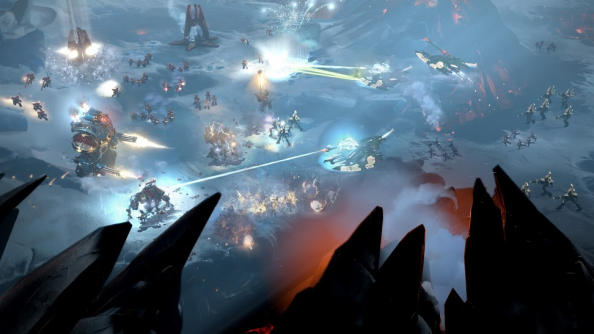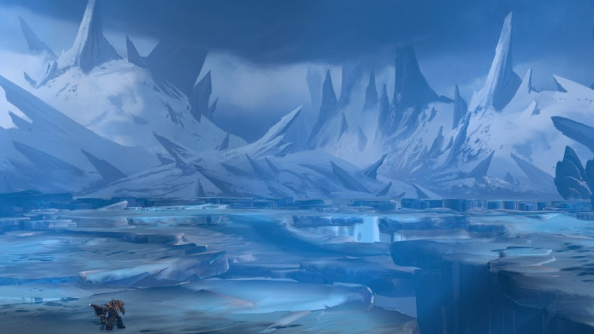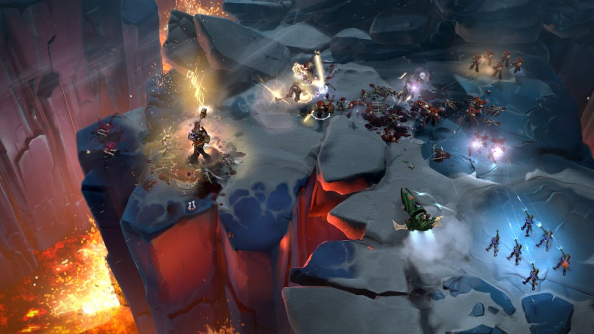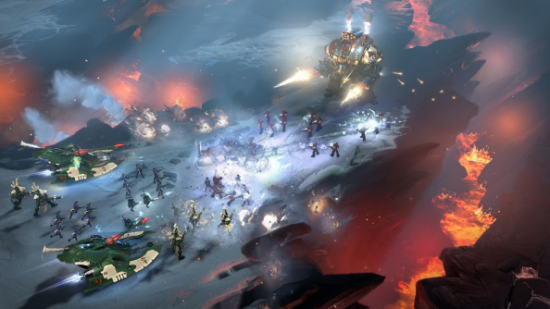In the grim darkness of the far future, there is only war. That’s the premise of Warhammer’s 40k universe, and it’d be a bleak and disheartening thing if not for one simple fact: war, at least as it’s portrayed in Relic’s strategy series, is awesome.
Here’s the full Warhammer 40k codex on Dawn of War III: release date, trailers and campaign details all in one place.
The Dawn of War series pedigree is strong enough that, among strategy gamers, ‘original vs sequel’ is a debate that rages as strongly as Alien vs Aliens (it’s the former, obviously). The first DoW let you build bases and bring together massive armies, while its successor focused on squad combat and much smaller engagements, but gave each of your squads more personality. Whichever side of the fence you fall on, what’s clear is that both are great.
And best of all – except for fans of pointless, unending debate – is that watching Dawn of War III in action confirms that it neatly manages to mix the best of both worlds: the scope of DoW1, the elite units and persistency of DoW2, and then a little magic all of its own.
Hero units, for instance. The first of these we’re introduced to is Space Marine and Blood Ravens chapter leader Gabriel Angelos. Each of the campaign’s heroes have their own particular set of skills, designed to fit a certain playstyle. Gabriel Angelos? Well, he’s a brawler, using his hammer (the wonderfully named god-splitter) to close distance and bring the pain to the Eldar he’s squashing.
Angelos seems simple at first glance. He has a leaping attack, landing with an almighty thud and doing damage to those around him, and his 360-degree spin of the hammer causes knockback, pushing units away. Game director Philippe Boulle says that even though Angelos is one of the easier heroes to get to grips with, he’s still got hidden depth. That leaping attack? It can be used to climb up and down cliffs. That knockback? It reflects all damage and can be used, if your timing is right, to bounce grenades and other explosives back at people you don’t like.
Heroes are part of a group Relic refer to as elite units. Either remarkable individuals or hardy squads, elites are distinct from the cannon fodder rank and file, sticking around between missions and levelling up over time. Space Marines will always feel like Space Marines, but you can choose which elite troops you want to take with you into battle, and this lets you tailor yourself to a certain theme, comparable to the flavour that commanders gave Company of Heroes 2, another Relic title. Low-cost but aggressive swarming units let you dominate the early game, while stupendously powerful late-game war machines let you wipe the floor with the enemy.
Looming above all the other elites, you have the gargantuan super units. These are pure power distilled down into one clickable 3D model – they’re even bigger than the dreadnoughts and much more scarce. Imperial Knight Solaria is the first of these digitised warriors and just so happens to be the largest unit Relic have ever made. With chainguns for arms and missiles adorning her shoulders as though they were military decorations, she’s a one-person weaponised monstrosity. While we haven’t seen what the other races are packing, it’s bound to be close in terms of wanton destruction.

These super units control the battlefield, and are often the centrepiece to battles, standing out while their enemies are tossed around like ragdolls. Boulle points out that although they’re definitely not making a MOBA, they’ve taken some design cues from the genre.
“Looking at MOBA heroes is something we do,” he says. “Our elites definitely have some of those elements that make MOBA heroes so compelling.”
To keep up with it all, base building has returned after its absence from DoW2. The Space Marine buildings are a mess of gleaming cogs and venting steam, with sparks and the sound of whirring accompanying each new unit’s birth into the field. They look good, too. There’s a sharpness to everything, so you can really appreciate the level of detail on those killing machines you’re churning out.
A core tenet of the single-player campaign is for there to be deep, readable systems alongside the spectacle. The aim is that, as the combat unfolds, you can keep an eye on everything and still have all the information you need to make decisions – and for those decisions to have a decisive impact.

The campaign is going to force you to chop and change between three races. You’ll be playing a Space Marine mission, then an Orc mission and then an Eldar mission before rotating back to the Space Marines again. While this means the team can experiment with the narrative a little more, it’s mostly about making the game accessible to people whether they’re new to the Warhammer 40k universe or have been playing DoW since its 2004 release. This will also give players a chance to see which of the three races they prefer, show them how the different factions interact, and help them learn what their different mechanics will feel like.
Don’t go thinking accessibility here is euphemistic for a more cut back experience. Boulle assures us that “accessibility for a strategy game does not mean dumbing it down” and fans should expect a Dawn of War game that has several layers of complexity to it, but is still decipherable to everyone. This means less time trying to understand the information presented to you, and more time working out who you want to blow up next, and with what.
Even though there are a lot fewer playable races this time, the three here have their own distinct flavours, and the team have been using internal codenames for their differing styles. The Space Marines, front and centre thus far, are the ‘Tip of The Spear’, delivering firepower in a concentrated fashion. That’s partly thanks to those elite units, but during the demo we were also shown drop-pods thudding to earth on the front lines, dispensing troops into the assault to keep everyone on their toes.

The Eldar are ‘Stormwind’, experienced in guerilla tactics and baiting enemies into traps. The Orcs, the ‘Maniac Horde’, are all about overwhelming enemies with their superior numbers rather than individual strength. These unique styles are what distinguish races from one another, but the super units can make two armies from the same race completely different.
In many ways it’s the biggest Dawn of War we’ve seen so far, and it’s on course for being one of the best looking renditions of the Warhammer 40k universe we’ve seen. For those of you that love giant armoured hulks, space-punching or even just some good real-time strategy, this is definitely one to watch.
